[Editor’s Note: Our “Contagion” series of posts continues, in response to our crowdsourcing prompt How Will the COVID-19 Global Pandemic Shape the Operational Environment? In today’s submission, returning guest blogger Ian Sullivan argues convincingly that the coronavirus is accelerating great power competition, thereby altering the trajectory of the Operational Environment. Read on to learn how COVID-19 is catalyzing competition, spurring on the geo-political rivalry that exists between China, Russia, and the United States!]
 As we all wait within what public health experts warn us is the most critical, and potentially most lethal phase of the global Coronavirus pandemic, it is easy to think that the world will never be the same. Over the last several months, as the virus rapidly and inexorably spread out of Hubei Province in China, we already have seen how different life is. The pandemic clearly is having a global impact. But is it having a system altering impact, or from the Army’s perspective, is it causing a shift in our assessment of the Operational Environment (OE)?
As we all wait within what public health experts warn us is the most critical, and potentially most lethal phase of the global Coronavirus pandemic, it is easy to think that the world will never be the same. Over the last several months, as the virus rapidly and inexorably spread out of Hubei Province in China, we already have seen how different life is. The pandemic clearly is having a global impact. But is it having a system altering impact, or from the Army’s perspective, is it causing a shift in our assessment of the Operational Environment (OE)?
In the first four months of 2020, this novel disease has slowed the gears of international commerce to a crawl, left wide swaths of the global population unable to earn a living, and compelled many businesses, and seemingly whole industries, to cease operations. The rush to fight the virus, to find or produce personal 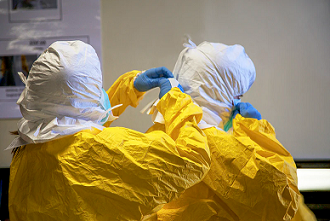 protective gear and medical equipment, research treatments and vaccines, and to support the exhausted and shaken health care professionals who are struggling to care for the ill has proven a challenge to governments, business, industry, and the scientific research community. Nations have struggled under the weight of the crisis in terms of organizing a public health response, in finding solutions that weigh a nation’s beliefs and principles in terms of balancing individual freedoms and public safety/order, and in focusing on supporting friends and allies, while facing true crises and demands by their populations to provide internal solutions. It has created challenges in the international security arena, as governments rely on militaries to help with internal responses to the disease, while at the same time endeavoring to protect their forces from the disease to maintain overall readiness.
protective gear and medical equipment, research treatments and vaccines, and to support the exhausted and shaken health care professionals who are struggling to care for the ill has proven a challenge to governments, business, industry, and the scientific research community. Nations have struggled under the weight of the crisis in terms of organizing a public health response, in finding solutions that weigh a nation’s beliefs and principles in terms of balancing individual freedoms and public safety/order, and in focusing on supporting friends and allies, while facing true crises and demands by their populations to provide internal solutions. It has created challenges in the international security arena, as governments rely on militaries to help with internal responses to the disease, while at the same time endeavoring to protect their forces from the disease to maintain overall readiness. 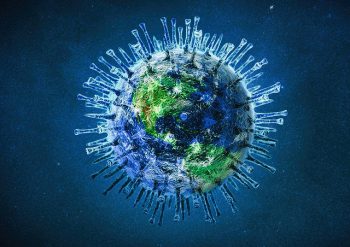 And there is the human cost of the disease, which as of 14 April has resulted in nearly 2 million infected and more than 120,000 deaths worldwide1, with these numbers increasing at alarming rates. With all of this in mind, it is easy to see why so many observers conclude that the COVID-19 pandemic represents a paradigm shift in the international system that perhaps becomes an indicator of change within the OE.
And there is the human cost of the disease, which as of 14 April has resulted in nearly 2 million infected and more than 120,000 deaths worldwide1, with these numbers increasing at alarming rates. With all of this in mind, it is easy to see why so many observers conclude that the COVID-19 pandemic represents a paradigm shift in the international system that perhaps becomes an indicator of change within the OE.
Much of the prevailing wisdom assumes that there will be long-lasting changes. For example, a recent article in Politico surveyed what it called “30 smart, macro thinkers” who argue that the pandemic is indeed an event that could be considered paradigm shifting. Although the piece looks largely through the lens of American life, it argues that a range of changes, from the normalization of the virtual/digital world, to a newfound affirmation for science and expertise, a widening of the gap between societal “haves and have nots,” and a re-definition of patriotism and a new respect for government service will result in the aftermath of 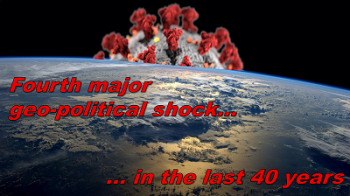 the pandemic.2 Thomas Wright, a Senior Fellow at the Brookings Institute, calls the COVID-19 pandemic the fourth major geo-political shock that has hit world in the last 40 years, preceded by the end of the Cold War, the 9/11 terrorist attacks, and the 2007-2009 global financial crisis.3 Other experts point to severe challenges to globalization, a shift in power from West to East, increased tensions between democracies and centralized governments, and a rise in failed states.4
the pandemic.2 Thomas Wright, a Senior Fellow at the Brookings Institute, calls the COVID-19 pandemic the fourth major geo-political shock that has hit world in the last 40 years, preceded by the end of the Cold War, the 9/11 terrorist attacks, and the 2007-2009 global financial crisis.3 Other experts point to severe challenges to globalization, a shift in power from West to East, increased tensions between democracies and centralized governments, and a rise in failed states.4
I am loathe to assess that any event is either system-altering or system-shattering in mid-stream, although the sheer scope and scale of the pandemic indicates that it will have a major impact on the development of the OE. Indeed, all of the points raised in the previous paragraphs are relevant, and deserve to be assessed  individually to determine their impact, and whether or not they, either singularly or as part of a broader sense of convergence across the diplomatic, information, military and economic (DIME) sphere will shift our underlying assessments. History offers us many cautionary tales of the dangers of making calls too early, or worse, realizing a change had come too late.
individually to determine their impact, and whether or not they, either singularly or as part of a broader sense of convergence across the diplomatic, information, military and economic (DIME) sphere will shift our underlying assessments. History offers us many cautionary tales of the dangers of making calls too early, or worse, realizing a change had come too late.
The history of pandemics does not really help us determine the potential impact of COVID-19. Several have indeed shattered systems, while others have had very little systemic effect. During the reign of the Byzantine Emperor Justinian I in the 6th Century, an outbreak of what likely was bubonic plague resulted in the death of an estimated 30 to 50 million people, which may have been equivalent of half of the world’s population at the time. This pandemic essentially destroyed international commerce, weakened Constantinople’s ability to defend its frontiers against its enemies, and abruptly halted Justinian’s effort to reunite the Eastern  and Western halves of the Roman Empire. The more well-known Black Death (1347-1351) had similar system-wide implications, killing 25 million in Europe, alone, with the world not reaching pre-1347 population levels for another 200 years. The Black Death marked the beginning of the end of feudalism, as so many peasants died as to make the practice of serfdom wane. It also, arguably, led to the first challenges to the dominance of the Roman Catholic Church, and
and Western halves of the Roman Empire. The more well-known Black Death (1347-1351) had similar system-wide implications, killing 25 million in Europe, alone, with the world not reaching pre-1347 population levels for another 200 years. The Black Death marked the beginning of the end of feudalism, as so many peasants died as to make the practice of serfdom wane. It also, arguably, led to the first challenges to the dominance of the Roman Catholic Church, and  possibly was the first spark on the road to the Reformation. Conversely, the 1918 Spanish Flu outbreak had a comparatively limited impact on the international order. Although the cost in lives was incredibly high, infecting 500 million people globally—which was then one-third of the world’s population—and killing over 50 million, the disease had a relatively limited impact on the global system save for advances in some medical technology and public health practices/awareness.5
possibly was the first spark on the road to the Reformation. Conversely, the 1918 Spanish Flu outbreak had a comparatively limited impact on the international order. Although the cost in lives was incredibly high, infecting 500 million people globally—which was then one-third of the world’s population—and killing over 50 million, the disease had a relatively limited impact on the global system save for advances in some medical technology and public health practices/awareness.5
So with these cautions in mind, how should we consider the impacts of the COVID-19 outbreak in terms of the OE? This pandemic is going to have a 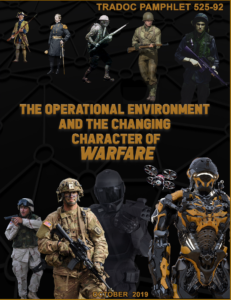 significant impact on the OE, but the impact is likely to be system-altering vice system-shattering. At the moment, it does not appear that the disease is going to fundamentally change or challenge the central paradigm of the OE, i.e., the great power competition that exists between the United States and its key pacing threats, China and Russia. It likely will, however, alter the relationship between the three in terms of broad national power across the DIME, as the pandemic and the resultant global response become an active theater in this competition space, with the rivalry between the United States and China becoming perhaps the dominant feature of international security. It also opens a whole new arena in the competition sphere, and opportunities for the pacing threats to advance their interests at the expense of the United States.
significant impact on the OE, but the impact is likely to be system-altering vice system-shattering. At the moment, it does not appear that the disease is going to fundamentally change or challenge the central paradigm of the OE, i.e., the great power competition that exists between the United States and its key pacing threats, China and Russia. It likely will, however, alter the relationship between the three in terms of broad national power across the DIME, as the pandemic and the resultant global response become an active theater in this competition space, with the rivalry between the United States and China becoming perhaps the dominant feature of international security. It also opens a whole new arena in the competition sphere, and opportunities for the pacing threats to advance their interests at the expense of the United States.
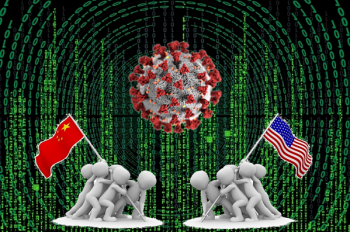 The disease may actually serve to accelerate this global competition, as powers seek to expand their ability to influence events, dominate the information space, and take advantage of the rapid development of new technologies. It also may cause greater separation in terms of relative whole-of-government power between China and Russia, with the former gaining in influence and the latter perhaps receding. Economic challenges likely will have a significant impact on military modernization as resources are necessarily shifted from key military research and development to necessary medical advancements and in buffering the population from the economic consequences of the pandemic. The information arena, which is assuming a central space during the COVID-19 outbreak, will cement its increasingly dominant role and will in many ways become the front line of a renewed competition between two competing power centers: Washington and Beijing.6
The disease may actually serve to accelerate this global competition, as powers seek to expand their ability to influence events, dominate the information space, and take advantage of the rapid development of new technologies. It also may cause greater separation in terms of relative whole-of-government power between China and Russia, with the former gaining in influence and the latter perhaps receding. Economic challenges likely will have a significant impact on military modernization as resources are necessarily shifted from key military research and development to necessary medical advancements and in buffering the population from the economic consequences of the pandemic. The information arena, which is assuming a central space during the COVID-19 outbreak, will cement its increasingly dominant role and will in many ways become the front line of a renewed competition between two competing power centers: Washington and Beijing.6
China clearly views the COVID-19 outbreak as an opportunity, and in an extraordinarily bold move is using the pandemic to demonstrate how adept Beijing has become at using the soft-power elements of the DIME sphere to its advantage, especially in the information space. Beijing has seemingly succeeded in shifting the narrative away from the initial outbreak of the disease around the city of Wuhan and its sluggish, but heavy-handed efforts to control the narrative and release needed information on the virus to the global medical community, which arguably set the conditions for the rapid expansion of the outbreak into a 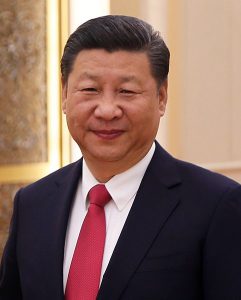 global pandemic. Instead, China is now using diplomacy and economic assistance coupled with a strong narrative lauding President Xi Jinping’s leadership and hard choices in combatting the virus within China to shift public perception away from blaming Beijing for the outbreak to considering it the leader of the global effort to fight the disease. In the words of Foreign Ministry spokesman Zhao Lijian, “China’s signature strength, efficiency, and speed in this fight has been widely acclaimed [and] set a new standard for the global efforts against the epidemic.”7
global pandemic. Instead, China is now using diplomacy and economic assistance coupled with a strong narrative lauding President Xi Jinping’s leadership and hard choices in combatting the virus within China to shift public perception away from blaming Beijing for the outbreak to considering it the leader of the global effort to fight the disease. In the words of Foreign Ministry spokesman Zhao Lijian, “China’s signature strength, efficiency, and speed in this fight has been widely acclaimed [and] set a new standard for the global efforts against the epidemic.”7
In addition to praising the Chinese response to the pandemic, Chinese information efforts have sought to deflect blame for causing the outbreak by waging a messaging campaign accusing the United States of starting the pandemic. Zhao Lijian again moved to the center of the story by issuing a series of Twitter posts on 12 March, alleging that the U.S. Army was responsible the start of the outbreak in Wuhan. A deeper review of these charges by Stanford University researchers indicate that the notion of a U.S. military role in the outbreak of the disease were found in Chinese-language social media posts as early as 2 January on YouTube, and ran consistently through February, well before Zhao’s statement.8 This indicates that the effort may have been focused internally as a way to insulate Xi and the Chinese Communist Party from their early failures in containing the disease before Beijing harnessed it as an external narrative.
China also is engaged in a broad global effort—named by some “Mask Diplomacy”—to generate goodwill abroad by sending medical assistance to nations stricken by the disease, with the message that its economic and social model is capable of providing global assistance, in contrast to the United States, which faces crippling shortages within its own borders.9 Masks, ventilators, and test kits have been sent to nations around the globe, from developed European nations to developing states in Africa and Southeast Asia, and have been accompanied by broad narratives aimed at demonstrating the superiority of the Chinese state-run system and the gratitude of other nations, many of whom are traditional U.S. partners and allies. This effort is reinforced by both covert cyber and information activity. 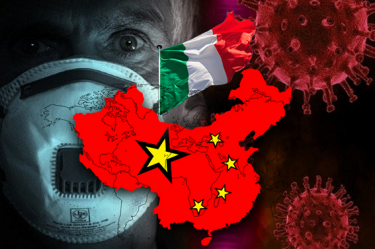 According to recent analysis from Italy, some 46 percent of tweets using the hashtag #forzaCinaeItalia (come on China and Italy) were generated by cyber bots, while 37 percent of #grazieCina (thanks China) tweets were also fabricated by bots. Furthermore, the Chinese Foreign Ministry posted a video of Italians in Rome applauding Italian health care workers from their balconies, but dubbed it with the Chinese national anthem and claims of “Grazie, Cina!”10 However, the impact of this effort has been muted by reports across Europe and Asia of the shoddy quality of the Chinese assistance—ineffective masks, inaccurate test kits, ventilators that quickly break down, etc.— which in turn likely has undercut its narrative.
According to recent analysis from Italy, some 46 percent of tweets using the hashtag #forzaCinaeItalia (come on China and Italy) were generated by cyber bots, while 37 percent of #grazieCina (thanks China) tweets were also fabricated by bots. Furthermore, the Chinese Foreign Ministry posted a video of Italians in Rome applauding Italian health care workers from their balconies, but dubbed it with the Chinese national anthem and claims of “Grazie, Cina!”10 However, the impact of this effort has been muted by reports across Europe and Asia of the shoddy quality of the Chinese assistance—ineffective masks, inaccurate test kits, ventilators that quickly break down, etc.— which in turn likely has undercut its narrative.
Russia is attempting a similar approach, although its efforts at actually supplying medical assistance to other nations have been on a smaller scale. Russia has, however, undertaken two very public efforts to provide assistance to Italy and the United States, although both efforts appear to be designed more for their propaganda value rather than anything else. Moscow’s information efforts appear to have two main threads; to paint the United States, NATO, and Western Europe as feckless, weak, or in some way responsible for events and to set an internal narrative on the overall effectiveness of President Vladimir Putin’s strong leadership.11 Russian state television proudly aired a photograph of the cavernous cargo compartment of an An-124 transport aircraft loaded with medical assistance bound for the United States as proof of this. Former US Army Europe commander, LTG (Ret) Ben Hodges wryly noted that “no professional loadmaster in the world…in any air force…would load a plane like this.”12
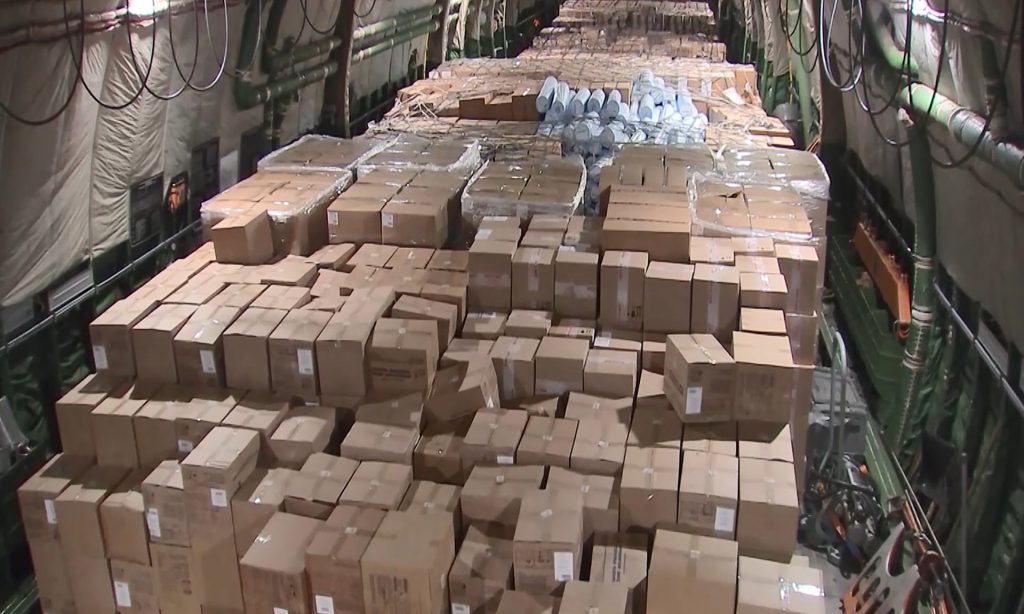

If Russia is unable to match China in terms of using diplomacy and economic assistance to extend its image and reach, it remains highly capable of flooding the information sphere with disinformation and propaganda. According a late March European Union (EU) study by its disinformation monitoring group, EU vs DiSiNFO, there have been at least 150 cases of pro-Kremlin disinformation focusing on COVID-19 and Europe.13 Notable themes include direct criticism of the EU’s efforts to handle the crisis, efforts to portray Russia as a responsible actor, and the gratitude of Europeans for Russian assistance, which have included claims that Italian citizens were tearing down EU flags and replacing them with Russian ones, and that Italians were playing the Russian national anthem in the streets. More insidious activities included a claim by a Russian senator that Poland denied Russian cargo aircraft carrying medical supplies to Italy access to Polish airspace and threats issued by the Russian Ministry of Defense against Italian journalists who penned an article questioning the value of Russian medical aid.14
So what does this mean for the OE? Most importantly, it confirms the importance of the great power competition construct. This is not going away any time soon and very likely will remain the dominant problem set moving forward through the mid-to-long term. It also may cause nations to re-order the importance they place on each element of the DIME, and reinforce that notion that military capability is not the sole arbiter of a nation’s power. The pandemic serves as an accelerant to trends we have been observing within the OE, namely the importance of whole-of-nation approaches to complex problems, the centrality of the information sphere, the need for resiliency against misinformation, a re-definition of national security to include topics like economic disruption and pandemic outbreaks, and the realities inherent in the rapidity of human interaction. It also illustrates that global events, be they naturally caused, like this pandemic, or man-made, like terrorist attacks, 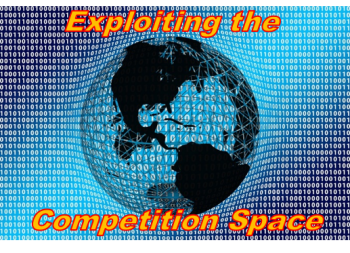 are opportunities that global powers will exploit in the competition space. The economic shocks to the system will be very real, and will have significant implications for years. In the near term, the nations with the largest and most diverse economies will be best positioned to handle the immediate post-pandemic world. This means that the United States and China may enjoy relative advantages that elevate their global influence. It also can lead to significant problems as poorer nations struggle to deal with the aftermath; failed states, humanitarian crises, and even conflicts could result and stress great powers who also will be reeling from the pandemic.
are opportunities that global powers will exploit in the competition space. The economic shocks to the system will be very real, and will have significant implications for years. In the near term, the nations with the largest and most diverse economies will be best positioned to handle the immediate post-pandemic world. This means that the United States and China may enjoy relative advantages that elevate their global influence. It also can lead to significant problems as poorer nations struggle to deal with the aftermath; failed states, humanitarian crises, and even conflicts could result and stress great powers who also will be reeling from the pandemic.
The COVID-19 pandemic likely will not have system-shattering impacts in the near-to-mid-term. But it will alter the trajectory of the OE. The most useful model to consider at the moment may be the Arab Spring, which had a definite system-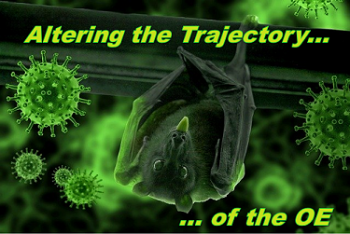 altering impact, and whose implications are still unfolding in new and unexpected ways a decade-plus after its dramatic onset. This pandemic may be a similar event, and we will not truly understand its impact for years. However, by analyzing its impacts, considering its second-and-third order effects, and asking the tough “so what” questions, the OE should prove resilient enough to make sure the Army and the nation are at least prepared for its potential long-term impacts with some key lessons learned and observations on the course of the future.
altering impact, and whose implications are still unfolding in new and unexpected ways a decade-plus after its dramatic onset. This pandemic may be a similar event, and we will not truly understand its impact for years. However, by analyzing its impacts, considering its second-and-third order effects, and asking the tough “so what” questions, the OE should prove resilient enough to make sure the Army and the nation are at least prepared for its potential long-term impacts with some key lessons learned and observations on the course of the future.
If you enjoyed this post, check out the preceding ones in this series:
Contagion: COVID-19’s impact on the Operational Environment (Part 1), by Chris Elles
Contagion: COVID-19’s impact on the Operational Environment (Part 2), by Kat Cassedy
Contagion: COVID-19’s impact on the Operational Environment (Part 3), by Vikram Venkatram and Dr. James Giordano.
… as well as Making the Future More Personal: The Oft-Forgotten Human Driver in Future’s Analysis, The Myth of Agincourt and Lessons on Army Modernization, and The Changing Dynamics of Innovation, by Mr. Ian Sullivan.
(Note: My thanks to Dr. Russell Glenn, Mr. Gary Phillips, and LTC Rob Taber for their thoughtful review and comment, which added significantly to this post.)
Ian Sullivan is the Assistant G-2, ISR and Futures, at Headquarters, TRADOC.
Disclaimer: The views expressed in this blog post do not necessarily reflect those of the Department of Defense, Department of the Army, Army Futures Command (AFC), or the Training and Doctrine Command (TRADOC).
1 Johns Hopkins University, Corona Virus Resource Center, accessed on 14 April 2020 at 0627 hrs, coronavirus.jhu.edu
2 Politico Magazine, “Coronavirus Will Change the World Permanently. Here’s How,” Politico, 19 March 2020.
3 Thomas Wright, “Order From Chaos: Stretching the International Order to Its Breaking Point,” Brookings Institute, 6 April 2020.
4 John Allen, Nicholas Burns, Laurie Garrett, Richard N. Haas, G. John Ikenberry, Kishore Mahbubani, Shivshankar Menon, Robin Niblett, Joseph S. Nye Jr., Shannon K. O’Neil, Kori Schake, and Stephen M. Walt, “How the World Will Look After the Coronavirus Pandemic,” Foreign Affairs, 20 March 2020.
5 Debanjali Bose, “11 Ways Pandemics Have Changed the Course of Human History, From the Over $4 Billion Spent to Fight Ebola to the Trillions it Might Take to Tackle the Coronavirus,” Business Insider, 20 March 2020.
6 Vanessa Molter and Graham Webster, “Coronavirus Conspiracy Claims: What’s Behind Chinese Diplomat’s COVID-19 Misdirection,” Stanford University FSI News, 31 March 2020.
7 Kurt M. Campbell and Rush Doshi, “The Coronavirus Could Reshape Global Order,” Foreign Affairs, 18 March 2020.
8 Ibid.
9 Will Knight, “China Flexes Its Soft Power With COVID Diplomacy,” Wired, 2 April 2020.
10 Charles Campbell, “China’s ‘Mask Diplomacy is Faltering. But the U.S. Isn’t Doing Any Better,” Time, 3 April 2020; and Francesco Bechis and Gabriele Carrer, “How China Unleashed Twitter Bots to Spread COVID-19 Propaganda in Italy,” Formiche, 31 March 2020.
11 James Makonkalns, “Russia Aids Italy in Fight Against COVID-19: Why We Should Be Aware,” Modern Diplomacy, 28 March 2020.
12 Robyn Dixon, “Trump Called Russian Coronavirus Aid to U.S. ‘Very Nice.’ Putin May Use it as a Propaganda Victory,” The Washington Post, 1 April 2020.
13 “EEAS Special Report Update: Short Assessment of Narratives and Disinformation Around the COVID-19 Pandemic,” EU vs DiSiNFO, 1 April 2020
14 “Coronavirus Disinformation: Moscow Overplays its Hand,” EU vs DiSiNFO, 8 April 2020.

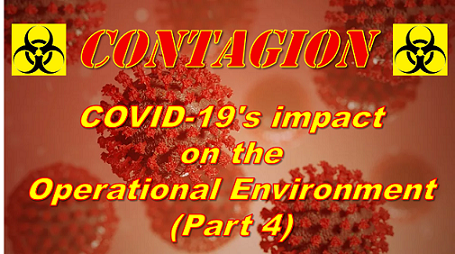


Concur that due to the persistence of a baseline in human psychology over the millennia, the response is likely to be that we will not incorporate L2 in a deep or meaningful way, and large scale changes are not likely. As you noted, outbreaks and pandemics are quite frequent in history even in the US, yet here we are today, repeating in an almost uncanny manner the 1918 failures and hasty attempts to pull the horse back into the barn while it is on fire. The initial panic and response to every new situation almost inevitably leads to passivity and a return to a “normalcy” and some sort of an equilibrium not far from the former one, in a ‘regression to the mean’ type of pattern.
That said, both wise men and evil men for millennia have always ‘taken advantage of chaos/crisis’. Our adversaries are doing this now, in ways even the most devious innovators in Nazi Germany’s propaganda machine could not have imagined. In a time when the US has been attacking and breaking down bonds between us and our allies, not merely a WOG but a WOA (Whole of Allies) should be our approach. We should be operating as a closely-knit mutually advisory group of nations dedicated to the free, democratic, science-catalyzed and other goals, not retreating into frightened nationalism which so often follows the emergence of threats.